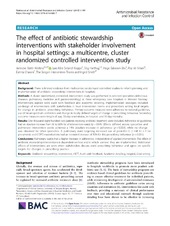| dc.contributor.author | Wathne, Jannicke Slettli | en_US |
| dc.contributor.author | Kleppe, Lars Kåre Selland | en_US |
| dc.contributor.author | Harthug, Stig | en_US |
| dc.contributor.author | Blix, Hege Salvesen | en_US |
| dc.contributor.author | Nilsen, Roy Miodini | en_US |
| dc.contributor.author | Charani, Esmita | en_US |
| dc.contributor.author | Smith, Ingrid | en_US |
| dc.date.accessioned | 2019-04-16T08:25:47Z | |
| dc.date.available | 2019-04-16T08:25:47Z | |
| dc.date.issued | 2018-09-10 | |
| dc.Published | Wathne JS, Kleppe LK, Harthug S, Blix HS, Nilsen RM, Charani E, Smith I. The effect of antibiotic stewardship interventions with stakeholder involvement in hospital settings: A multicentre, cluster randomized controlled intervention study. Antimicrobial Resistance and Infection Control. 2018;7:109 | eng |
| dc.identifier.issn | 2047-2994 | |
| dc.identifier.uri | https://hdl.handle.net/1956/19344 | |
| dc.description.abstract | Background: There is limited evidence from multicenter, randomized controlled studies to inform planning and implementation of antibiotic stewardship interventions in hospitals. Methods: A cluster randomized, controlled, intervention study was performed in selected specialities (infectious diseases, pulmonary medicine and gastroenterology) at three emergency care hospitals in Western Norway. Interventions applied were audit with feedback and academic detailing. Implementation strategies included co-design of interventions with stakeholders in local intervention teams and prescribers setting local targets for change in antibiotic prescribing behaviour. Primary outcome measures were adherence to national guidelines, use of broad-spectrum antibiotics and change in locally defined targets of change in prescribing behaviour. Secondary outcome measures were length of stay, 30-day readmission, in-hospital- and 30-day mortality. Results: One thousand eight hundred two patients receiving antibiotic treatment were included. Adherence to guidelines had an absolute increase from 60 to 66% for all intervention wards (p = 0.04). Effects differed across specialties and pulmonary intervention wards achieved a 14% absolute increase in adherence (p = 0.003), while no change was observed for other specialties. A pulmonary ward targeting increased use of penicillin G 2 mill IU × 4 for pneumonia and COPD exacerbations had an intended increase of 30% for this prescribing behaviour (p < 0.001). Conclusions: Pulmonary wards had a higher increase in adherence, independent of applied intervention. The effect of antibiotic stewardship interventions is dependent on how and in which context they are implemented. Additional effects of interventions are seen when stakeholders discuss ward prescribing behaviour and agree on specific targets for changes in prescribing practice. | en_US |
| dc.language.iso | eng | eng |
| dc.publisher | BioMed Central | eng |
| dc.rights | Attribution CC BY | eng |
| dc.rights.uri | http://creativecommons.org/licenses/by/4.0 | eng |
| dc.subject | Antibiotic stewardship | eng |
| dc.subject | Intervention | eng |
| dc.subject | cRCT | eng |
| dc.subject | Audit with feedback | eng |
| dc.subject | Academic detailing | eng |
| dc.subject | Hospital | eng |
| dc.subject | Goal setting | eng |
| dc.title | The effect of antibiotic stewardship interventions with stakeholder involvement in hospital settings: A multicentre, cluster randomized controlled intervention study | en_US |
| dc.type | Peer reviewed | |
| dc.type | Journal article | |
| dc.date.updated | 2018-09-28T07:56:11Z | |
| dc.description.version | publishedVersion | en_US |
| dc.rights.holder | Copyright 2018 The Authors | |
| dc.identifier.doi | https://doi.org/10.1186/s13756-018-0400-7 | |
| dc.identifier.cristin | 1613484 | |
| dc.source.journal | Antimicrobial Resistance and Infection Control | |

